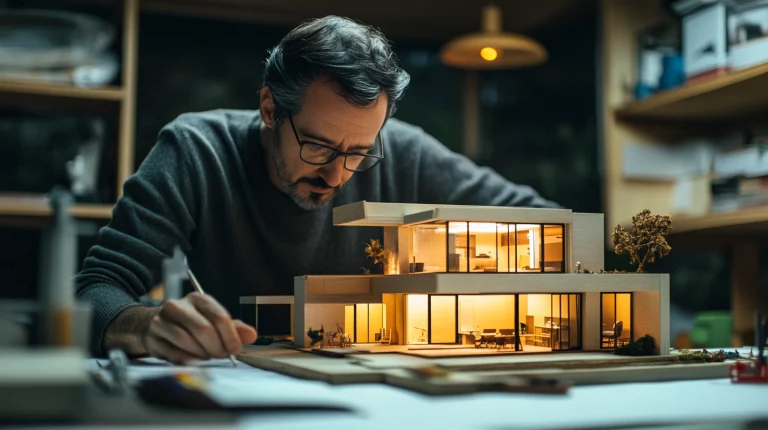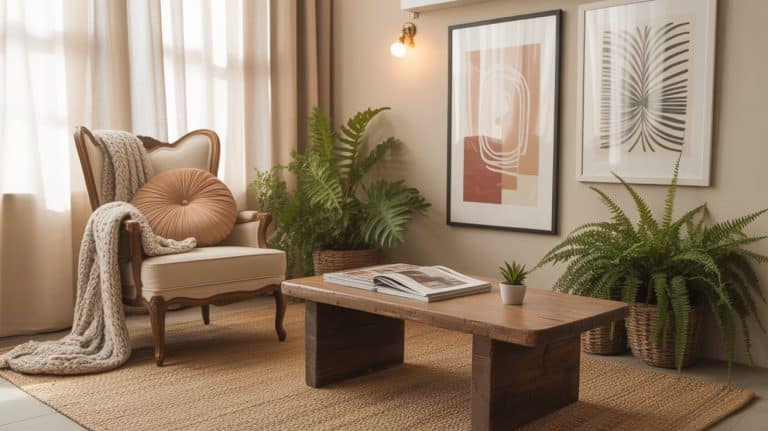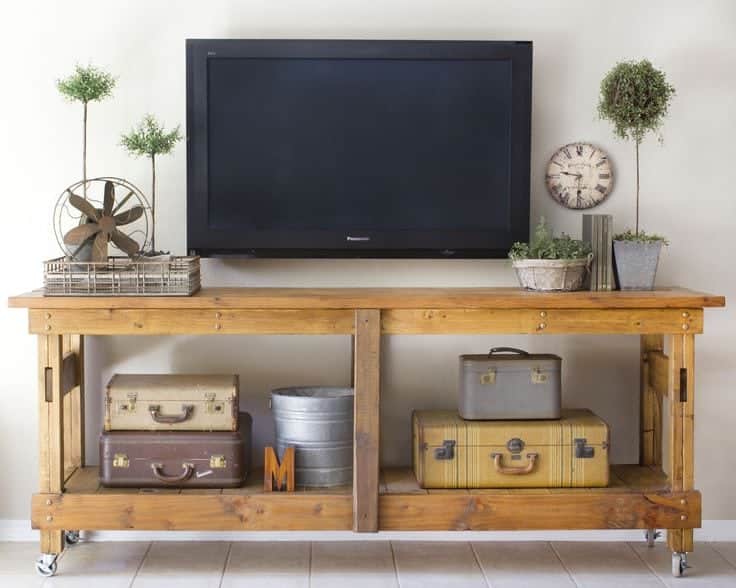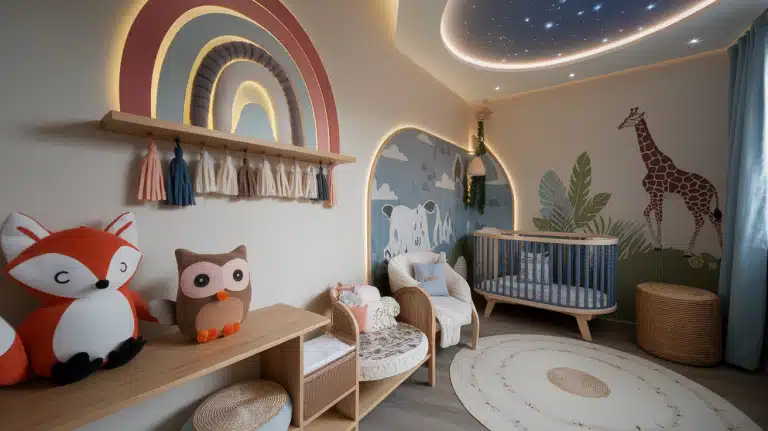12 Ways to Make Your Small Bedroom Feel Spacious
Ever feel like your bedroom walls are closing in? Small bedrooms can feel tight and uncomfortable. You bump into furniture. There’s no room to breathe.
But size doesn’t define comfort. Wise choices can open up any space. The right approach makes tiny rooms feel twice as big. No construction needed at all.
You’ll learn practical tricks that work. These methods use light, color, and clever layout to your advantage. Anyone can apply them starting today. Your bedroom will feel completely different than before.
Let’s turn that cramped space into a room you love spending time in. These proven methods will show you exactly how to make a small bedroom look bigger.
Why Do Small Bedrooms Feel so Cramped?
Small bedrooms feel tight for several clear reasons. Dark paint absorbs light and visually pushes walls inward. Big, bulky furniture blocks natural movement paths throughout the room.
Too many items create visual noise that overwhelms our eyes. When every surface holds something, the brain has no place to rest.
Bad lighting exacerbates these problems. Dim rooms feel like caves with no escape. Shadows conceal corners and significantly reduce the visible space.
Natural light can’t reach every area when windows are blocked. Poor layout wastes the precious space you do have. Furniture pushed against every wall creates dead zones in the center.
Factors that make bedrooms feel cramped:
- Low ceilings seem to press down.
- Busy patterns fragment the space.
- Multiple colors break up the visual flow.
- Closed storage hides too much from view.
- Heavy fabrics and materials feel oppressive.
- Lack of mirrors limits depth perception.
- Floor clutter blocks walking paths.
Can Design Convert a Small Bedroom Into a Larger Space?
Yes, design absolutely changes how we perceive space. Our brains process visual cues to judge room size. Light, color, and innovative arrangement trick our eyes into seeing more square footage than exists.
These aren’t gimmicks, they’re based on how human vision works. Think about mirrors in restaurant bathrooms. They make tiny spaces feel double their actual size. The same principles apply in bedrooms.
Design changes that fool the eye:
- Vertical lines: They draw the gaze upward.
- Transparent materials: These preserve sight lines.
- Consistent colors: They remove visual barriers.
- Floating furniture: It reveals more of the floor.
- Strategic lighting: This brightens dark corners.
- Proper scale: It maintains balanced proportions.
- Negative space: This gives rooms breathing room.
Strategic placement of reflective surfaces, proper lighting angles, and color choices all work together. Professional designers use these techniques daily to make cramped apartments feel spacious.
12 Ways to Make a Small Bedroom Look Bigger
Small bedrooms need creative solutions. These twelve methods use proven design principles to expand visual space. Apply them individually or combine for maximum effect.
1. Use Light, Neutral Wall Colors

Soft shades, such as white, light cream, and pastel colors, can brighten a room, making it appear more spacious and welcoming.
For a cohesive look, opt for one light color throughout the room. Tones like soft beige or ivory can enhance the height of your ceiling, creating an open and airy effect.
2. Maximize Natural Light with Sheer Curtains

Heavy drapes block precious sunlight from entering. Sheer curtains filter light gently while maintaining privacy. They create soft, bright atmospheres without darkness.
Choose white or cream sheers that blend with the walls. Hang them from the ceiling to the floor for height. Natural light fills the space throughout the day.
3. Choose Low-Profile Furniture

Tall, bulky furniture overwhelms small spaces. Low-profile pieces keep sight lines open. Platform beds and short dressers preserve wall visibility.
Select furniture with visible legs underneath. Wall-mounted nightstands float without taking up floor space. Size pieces proportionally to match your room.
4. Use Mirrors to Reflect Light and Space

Mirrors are an effective tool for expanding the perceived size of a room. Placing large mirrors across from windows helps reflect light, enhancing the room’s depth.
Full-length mirrors are practical for dressing and also visually enlarge the room. Mirrored closet doors and strategically placed mirrors can amplify the effect.
5. Opt for Multi-Functional Furniture

Each piece must work hard in small spaces. Storage benches not only hide blankets but also provide seating. Beds with drawer bases replace separate dressers.
Wall-mounted desks fold flat when idle. Nesting tables stack together neatly. These items are adaptable without requiring permanent floor claims.
6. Declutter and Keep Surfaces Clean

Clutter gives the illusion of a smaller space. Keeping surfaces clear, especially on nightstands and dressers, ensures the room feels open. Opt for transparent or minimalistic decor to maintain a spacious atmosphere.
Select fewer, more meaningful decor pieces to avoid overcrowding your room. Embrace the value of space, and remember that regular tidying helps sustain a clutter-free and open environment.
7. Mount Shelves and Lights on Walls

Table lamps waste precious surface area. Wall sconces provide light without the need for tables. Adjustable reading lights work excellently bedside.
Floating shelves store items vertically. Install them in empty corners or above desks. Wall mounting clears eye-level clutter completely.
8. Keep Floor Space Open

Exposing the floor creates a sense of spaciousness. Avoid pushing all furniture to the edges; instead, let some pieces float inward to maintain an open, flowing space.
Opt for furniture with visible legs to create a sense of spaciousness. Clear or glass tables contribute to a lighter look, while using minimal floor coverings maintains uninterrupted visual flow.
9. Use Vertical Space with Tall Shelves or Vertical Patterns

Height draws attention upward. Ceiling-high bookcases store more vertically. Narrow, tall furniture beats wide, short pieces.
Vertical wallpaper stripes suggest extra height. Arrange artwork in columns rather than rows. These visual guides make rooms feel taller.
10. Hang Curtains Closer to the Ceiling

Low curtains make windows look small. Mount rods near the ceiling instead. This trick adds instant visual height.
Let the curtains almost touch the floor. Long fabric lines deceive the eye into perceiving taller walls. Buy panels wider than windows for grandness.
11. Opt for Light-Colored Flooring

Light flooring expands visual space just like light walls do. Pale hardwood, light laminate, or cream carpets reflect more light upward. They create an unbroken flow from the floor to the walls.
Choose flooring two shades lighter than your walls. This gradual color transition makes rooms feel taller. Avoid dark rugs that create visual boundaries on floors.
12. Consider Light Ceiling Treatments

White or pale ceilings visually lift the room’s height. Paint ceilings the same color as walls or one shade lighter. This removes the visual “lid” that dark ceilings create.
Add subtle horizontal stripes for an extra height illusion. Crown molding in matching light colors helps, too. These ceiling tricks make small bedrooms feel more open above.
How to Maintain that Spacious Feel Over Time?
Creating space is just the beginning. Maintaining it requires daily habits that protect your progress. Small, consistent actions prevent clutter from creeping back and ruining your hard work.
Maintenance strategies to consider:
- Five-minute morning tidy: Make the bed and wipe down all surfaces.
- Nightly reset: Return clothes and items to their designated places.
- Weekly deep clean: Dust surfaces and vacuum under furniture.
- Monthly clutter check: Remove items that don’t belong.
- Seasonal donation run: Clear out unused belongings.
- One in, one out rule: Match new purchases with donations.
Conclusion
Small bedrooms don’t have to feel cramped. These strategies work together to create spacious feelings. Light colors, wise furniture choices, and good organization make dramatic differences.
You don’t need all the methods at once. Start with one or two changes. Paint your walls lighter. Add a mirror. See how much better your room feels.
Remember, perception creates reality in design. Your small bedroom can feel twice its actual size. The right choices trick your brain into seeing more space.
What idea appeals to you most? Let us know your thoughts or questions in the comments. Your experience could help others dealing with cramped bedrooms as well.
Frequently Asked Questions
Where to Position a Bed in A Small Bedroom?
Place the bed against the most visible wall. Corner placement saves space. Leave a walking room around it. Keep windows closed for better sleep.
Should Bedroom TV Be High or Low?
Mount the bedroom TVs approximately 50 inches from the floor to the center of the screen. This height works well for watching while lying in bed comfortably.
How Far Above the Dresser to Hang a TV?
Position the TV center 42 inches from the floor. Leave several inches between the dresser top and the TV bottom. This prevents neck strain while watching.







